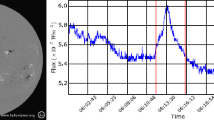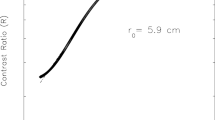Abstract
Straylight effects in solar intensity images have been framed in a well-established mathematical formulation (Chae et al., 1998a, b). Many procedures can be applied to recover the point spread function (PSF) and correct the atmospheric and instrumental distortions. Concerning velocity data, some procedures to make corrections for straylight have been addressed. Many experiments infer the velocity as the mean displacement of a spectral line and build a Dopplergram as a nonlinear combination of the intensity images sampled at different wavelengths. Unfortunately, often only the final products are available and it is not possible to apply an appropriate correction to the individual intensity images. A standard procedure to correct for the straylight has been applied to a time-series of velocity data and the results have been controlled in the single Dopplergram (that seems to be good) and in a power spectrum at the atmospheric frequencies (where any correction should reduce the power). These frequencies are characteristic of the observing site and typically in the range of the g modes: this means that no long run from a network would decrease their contribution to the noise. The results show that the correction procedures, based on the intensity and velocity gradients, are not reliable if controlled in the power spectrum. This conclusion has led to a change of the acquisition procedure at the Kanzelhöhe Solar Observatory, where now the individual intensity images that build the Dopplergram are stored.
Similar content being viewed by others
References
Albregtsen, F. and Andersen, B. N.: 1985, Solar Phys. 95, 239.
Barducci, A., Cavallini, F., Ceppatelli, G., Righini, A.: 1990, Astron. Astrophys. 240, 203.
Cacciani, A. and Moretti, P. F.: 1994, Instr. Astron. VIII, SPIE 2198, 219.
Cacciani, A., Moretti, P. F. and Rodgers, W. E.: 1997, Solar Phys. 174, 115.
Cacciani, A., Moretti, P. F., Messerotti, M., Hanslmeier, A., Otruba, W., and Pettauer, T. V.: 1999, in A. Hanslmeier and M. Messerotti (eds.), Motions in the Solar Atmosphere, Kluwer Academic Publishers, Dordrecht, p. 271.
Chae, J., Yun, H. S., Sakurai, T., and Ichimoto, K.: 1998a, Solar Phys. 183, 229.
Chae, J., Yun, H. S., Sakurai, T., and Ichimoto, K.: 1998b, Solar Phys. 183, 245.
Harvey, J. W. and the GONG Instrument Team: 1988, in E. Rolfe (ed.), Seismology of the Sun and Sun-like Stars Symposium, ESA SP-286, p. 203.
Jefferies, S. M., Christou, J. C., Hege, E. K.: 1999, Optics Letters, submitted.
Martinez Pillet, V., Ruiz Cobo, B., and Vasquez, M.: 1990, Solar Phys. 125, 211.
Rhodes, E. J., Cacciani, A., Korzennik, S., Tomczyk, S., Ulrich, R. K., and Woodard, M. F.: 1990, Astrophys. J. 351, 687.
Author information
Authors and Affiliations
Rights and permissions
About this article
Cite this article
Moretti, P. Can Dopplergrams be corrected for straylight?. Solar Physics 196, 299–309 (2000). https://doi.org/10.1023/A:1005201508146
Issue Date:
DOI: https://doi.org/10.1023/A:1005201508146




